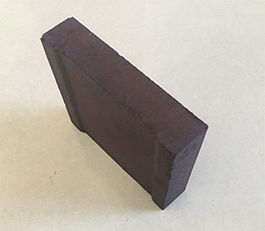Refractory products with periclase as the main mineral component. Magnesia-carbon bricks can be divided into magnesium bricks made of magnesia made of magnesia bricks, magnesium-aluminum bricks with a small amount of special alumina industrial alumina, magnesium-carbon bricks with a certain amount of graphite powder. , Magnesia-silica brick made of poor quality high-silica magnesia. Compared with other refractory bricks, magnesia bricks have a higher fire resistance, which can reach above 2000 ° C, have a higher load softening temperature, greater high temperature mechanical strength, have good resistance to iron oxide calcium oxide. Chemical attack performance of alkaline slag. But generally the thermal stability is poor. The magnesium oxide content in the product is about 85%. Alkaline refractory with alumina content of 5% to 10%, with periclase as the main crystalline phase magnesia-alumina spinel as the subcrystalline phase (as the main binding phase). The apparent porosity is generally 15-18%. The thermal expansion coefficient is 10.6 × 10-6 / ° C. The thermal shock resistance is better than that of magnesium bricks which are similar to magnesium aluminum bricks. Because the matrix has high melting point magnesia-alumina spinel, its high temperature strength is high, the starting temperature of load is above 1580 ° C. Slag resistance is also good. Generally, high-quality sintered magnesia is used as a granular material, a fine powder composed of magnesia mixed with raw alumina light-fired alumina clinker industrial alumina is added mixed, shaped fired.
Ways to improve the thermal shock resistance of refractories
1. Reduce thermal stress caused by expansion: The kiln furniture uses a material with a small thermal expansion coefficient, a material with a small thermal expansion coefficient is doped in the kiln furniture, which can reduce the thermal expansion of the crystal phase, thereby reducing thermal stress. In addition, when the main crystalline phase inside the kiln furniture is thermally expanded, if there is a certain space inside the structure, which can accommodate a certain degree of deformation, it can play a role in mitigating thermal stress. The main methods are:
(1) Introduce materials with low expansion coefficient.
(2) A large number of micro air holes are set in the kiln.
(3) Introduce a negative expansion mechanism.

2. Formation of micro-crack networks: Micro-cracks contribute to the improvement of the material's fracture surface energy. These cracks absorb the elastic strain energy reduce the energy that drives the main crack propagation, thereby increasing the material's fracture surface energy. In addition, these microcracks also contribute to reducing the elastic modulus of the material, which only improves the fracture surface energy, but also reduces the elastic modulus, which can improve the thermal shock resistance of the material. The main methods are:
(1) Control the particle match.
(2) Thermal expansion mismatch.
Antique green brick is a product of China's construction of magnesium carbon brick ceramic industry, but was imported abroad. Antique tiles are evolved colored glazed tiles, which are essentially glazed porcelain tiles. Antique tiles are ordinary tiles, which are basically the same as magnetic sheets. The so-called antique refers to the effect of bricks. It should be called antique tiles. Antique tiles are difficult to clean. After sintering at a high temperature of 1000 degrees, it has high strength strong abrasion resistance. The carefully developed antique green brick has both water resistance, non-slip corrosion resistance. Talking about innovation brand the value chain of the product; talking about imitation innovation independent innovation the introduction, digestion absorption; finally putting forward some views on the future development of antique blue bricks.
Antique blue bricks of ancient architecture: made pure clay; after the process of drinking water, it is blue-gray; different ordinary antique ceramic tiles (such as porcelain tiles, vitrified bricks, etc.), ancient blue bricks are elegant , Calm, quaint, natural, quiet beauty; with the characteristics of breathability, water absorption, oxidation resistance, air purification, etc., it is an ideal decoration material for house wall pavement decoration. In recent years, it has become one of the products highly recommended by designers.
Antique green bricks originated European glazed bricks. They were first introduced to the mainland by Taiwanese businessmen, were called pan ancient bricks. Later, they were called classical bricks, vintage bricks, antique bricks. Too much, everyone is used to it, the habit becomes natural, it becomes the brand name of similar bricks. Europeans often refer to ancient Greek Roman architecture, Tidal Vinci Michelangelo; to French Impressionist landscape painter Sisley (1839-1899) famous Dutch painter Van Gogh his masterpiece sunflower; imitation magnesium Carbon brick ancient blue brick belongs to glazed brick. The development trend of its green body is mainly porcelain (water absorption rate & le; 0.5%), there are also porcelain ceramics (water absorption rate 0.5 ~ 3%) fine concrete (water absorption). The rate is 3 to 6%), the concrete quality (water absorption rate is 6 to 10%) can refer to 41001 porcelain tiles; 41002 tiles; 41003 fine tiles 41004 tiles in the GB / T4100-1999 ceramic tile standard.
Welcome to inquire
+86 18640735333
Mobile: +86 18640735333 Mr. Yang
Email: Yangkaiyi0368@163.com
Address: West Outer Ring, Dashiqiao Economic Development Zone, Yingkou, Liaoning Province
